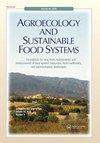Effect of external factors on the stability of sparkling wine quality during storage
IF 2.6
3区 农林科学
Q1 AGRICULTURE, MULTIDISCIPLINARY
Agroecology and Sustainable Food Systems
Pub Date : 2023-07-12
DOI:10.21323/2618-9771-2023-6-2-130-138
引用次数: 0
Abstract
The shelf life of sparkling wine is an indicator that can vary depending on the impact of a large number of external factors on the product. These factors include transportation conditions, storage temperature, humidity, exposure to light, and packaging quality. The current regulatory documentation regulates certain requirements for the storage conditions of sparkling wines, but they are often violated during transportation and storage, which leads to a significant deterioration in the quality of products. This review is devoted to the study of changes in the quality characteristics of wines during their storage and transportation. It is shown that the intensity of physicochemical changes occurring in wine during storage depends on temperature conditions, the presence of vibration and exposure to light. The issue of the influence of temperature storage conditions on the quality characteristics of wine products, including sparkling wines, has been studied in some detail. Most researchers are of the opinion that in order to maintain a stable quality of wine, it is necessary to store and transport it at a constant temperature not exceeding 20 °C. In scientific publications, there are different views on the problem of the influence of bottle color on the change in chemical composition and the preservation of the quality characteristics of both still and sparkling wines during storage. It has been found that bottles made of darker glass allow protecting wine to a greater extent from the effects of light, especially in its ultraviolet and visible short-wave (λ = 400 nm) range, and prevent the appearance of the so-called “taste of light” (gout de lumière) in the wine. It is shown that the causes of the appearance of the “taste of light” in champagne are sulfur-containing compounds formed as a result of photochemical reactions. It has been found that the intensity of these reactions depends on the degree of illumination, as well as the presence of riboflavin and iron (III) ions in the wine. It is concluded that controlling the amount of light to which wines are exposed can prevent deterioration of their quality during storage and extend the shelf life. The possibility of preventing photodegradation of wine through the use of various antioxidants is also considered. Based on the information available in scientific publications, the study of the development of negative changes in wine under the influence of light is an important aspect from the point of view of risk assessment during product storage.外部因素对起泡酒贮藏质量稳定性的影响
气泡酒的保质期是一个指标,它可以根据大量外部因素对产品的影响而变化。这些因素包括运输条件、储存温度、湿度、光照和包装质量。目前的监管文件对起泡酒的储存条件有一定的要求,但在运输和储存过程中经常违反这些要求,导致产品质量严重下降。本文对葡萄酒在贮存和运输过程中品质特性的变化进行了研究。研究表明,葡萄酒在储存过程中发生的物理化学变化的强度取决于温度条件、振动和光照的存在。本文对温度贮藏条件对葡萄酒产品(包括起泡酒)品质特性的影响进行了较为详细的研究。大多数研究人员认为,为了保持葡萄酒的稳定品质,有必要在不超过20℃的恒温下储存和运输。在科学出版物中,对于酒瓶颜色对静止酒和起泡酒在储存过程中化学成分变化的影响以及品质特征的保存问题,有不同的看法。人们发现,深色玻璃制成的瓶子可以在更大程度上保护葡萄酒免受光线的影响,特别是在紫外线和可见光短波(λ = 400 nm)范围内,并防止葡萄酒中出现所谓的“光的味道”(gout de lumi)。结果表明,香槟中出现“光的味道”的原因是由于光化学反应而形成的含硫化合物。已经发现,这些反应的强度取决于光照的程度,以及葡萄酒中核黄素和铁(III)离子的存在。结果表明,控制葡萄酒的光照量可以防止葡萄酒在储存过程中质量的恶化,延长葡萄酒的保质期。本文还讨论了通过使用各种抗氧化剂来防止葡萄酒光降解的可能性。根据科学出版物提供的信息,从产品储存期间风险评估的角度来看,研究光线影响下葡萄酒负变化的发展是一个重要方面。
本文章由计算机程序翻译,如有差异,请以英文原文为准。
求助全文
约1分钟内获得全文
求助全文
来源期刊

Agroecology and Sustainable Food Systems
AGRICULTURE, MULTIDISCIPLINARY-GREEN & SUSTAINABLE SCIENCE & TECHNOLOGY
CiteScore
4.80
自引率
7.70%
发文量
73
期刊介绍:
Agroecology and Sustainable Food Systems is devoted to the rapidly emerging fields of agroecology and food system sustainability. By linking scientific inquiry and productive practice with transformative social action, agroecology provides a foundation for developing the alternative food systems of the future. The journal focuses on the changes that need to occur in the design and management of our food systems in order to balance natural resource use and environmental protection with the needs of production, economic viability, food security, and the social well-being of all people.
Agroecology and Sustainable Food Systems examines our current food systems from production to consumption, and the urgent need to transition to long-term sustainability. The journal promotes the study and application of agroecology for developing alternatives to the complex problems of resource depletion, environmental degradation, a narrowing of agrobiodiversity, continued world hunger, consolidation and industrialization of the food system, climate change, and the loss of farm land. The journal uses a food systems approach, and seeks experiences in agroecology that are on-farm, participatory, change-oriented, and backed by broad-based methodologies of sustainability analysis and evaluation.
 求助内容:
求助内容: 应助结果提醒方式:
应助结果提醒方式:


